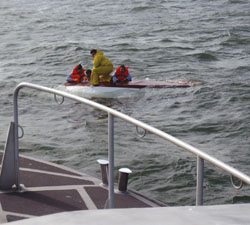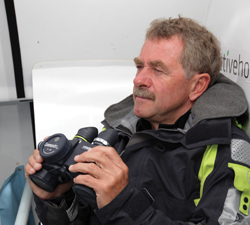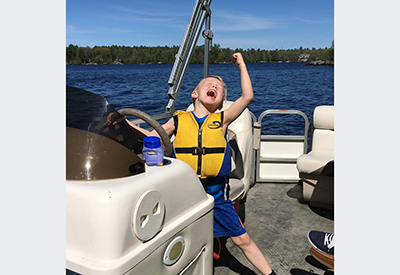Eye Protection for Boaters

 For many years now we have been listening to weather reports warning about the daily UV sun levels. They are warning us about two types of ultraviolet rays (UV rays) from the sun that can damage our eyes and skin called UV-A and UV-B rays. Ultraviolet light is high energy invisible light that can penetrate exposed parts of the body. Exposure to UV-B (the stronger of the two) has been linked with the formation of cataracts, photokeratitis (snow-blindness), skin cancer of the eyelids (or other parts of our exposed skin), benign growths on the eye’s surface, and other premature ageing of tissues such as wrinkles. Overexposure to UV-A is believed to be a contributing factor to macular degeneration. UV-C, which is stronger than UV-B, never reaches the earth’s surface since it is filtered out by the atmosphere. Chronic or repeated UV exposure causes many of these conditions when the eyes are not protected properly.
For many years now we have been listening to weather reports warning about the daily UV sun levels. They are warning us about two types of ultraviolet rays (UV rays) from the sun that can damage our eyes and skin called UV-A and UV-B rays. Ultraviolet light is high energy invisible light that can penetrate exposed parts of the body. Exposure to UV-B (the stronger of the two) has been linked with the formation of cataracts, photokeratitis (snow-blindness), skin cancer of the eyelids (or other parts of our exposed skin), benign growths on the eye’s surface, and other premature ageing of tissues such as wrinkles. Overexposure to UV-A is believed to be a contributing factor to macular degeneration. UV-C, which is stronger than UV-B, never reaches the earth’s surface since it is filtered out by the atmosphere. Chronic or repeated UV exposure causes many of these conditions when the eyes are not protected properly.
So what is the best way to protect those eyes? Is it that funky pink pair, the cool blue ones, or maybe … The UV protection can be 100% even in clear lenses. The tint is more a mater of comfort, style, and personal preference, but make sure the label says UV400 or blocks 100% UVA and UVB for the best protection possible for your eyes.
Fishermen have discovered for quite some time that polarized lenses enable them to catch more fish when in shallow waters, because they greatly reduce the light reflected off the water’s surface. This enhances the ability to see what lurks below the water’s surface, a feature that is also useful to boaters enabling them to see shoals, rocks, debris, or deadheads just below the surface. Polarized lenses are considered premium lenses with superior performance where a surface reflects light because as light is reflected, it is itself getting polarized. One word of caution here though, the LCD screens on much of the electronic equipment that we use is also polarized. If these devices are properly designed and manufactured (and the sunglasses themselves also), it is not a problem unless you lean over or tilt your head, then you’ll see only a black screen. Two polarized lenses with the polarizing axis parallel to each other will still transmit light, but once they are crossed 90 degrees to each other, then no light will pass through. Polarized lenses have 100% UV protection automatically built-in.
Other tint considerations are: gray is neutral and will not distort colours, brown and amber help with contrast by cutting through the haze on those hot summer days because they block blue light, green is not used as much anymore due to some colour distortion when compared to gray, and a whole slew of other colours which can either be cosmetic or enhancing such as shooter’s orange. Special coatings similar to those found on cameras and other optical devices called anti-reflective coatings help with reflections from the lenses themselves. Mirror coatings are sometimes used as well to reflect light much like one way glass does. Just make sure to cover the nose and cheeks well with a good sunscreen, because the extra light reflected from mirrored lenses will quickly burn these to a crisp.
The frame that holds the lenses is also important; you need something that blocks light from coming in around those lenses. Something that wraps around your face will minimize extraneous light, but if you wear prescription lenses, that may not be possible unless you can get one with an insert. Make sure that they have protection from the sides, top, and bottom as well. Weight is a big factor in comfort. The overall quality and fit will also affect comfort, durability, and whether or not you loose them overboard the first time you peer at something in the water. Don’t forget to use a band to help make those sunglasses extra secure for activities such as high speed PWC.
One activity that we usually neglect but that is equally important to UV protection; is protecting our eyes during maintenance. Whether it’s bottom paint work, or lead acid battery maintenance, a good pair of goggles can make a world of difference ensuring that we will continue to see tomorrow as well as we see today. Don’t take a chance with those eyes, without proper protection it is like playing Russian roulette.
So next time you head out to the boat, don’t forget your eye protection, or better yet, keep some on the boat itself. That way you cannot forget them at home. Your sunglasses and goggles are just as important as your sunscreen, hat, pfd, and all the safety equipment onboard, so use them and your eyes will reward you with a lifetime of good vision.





























